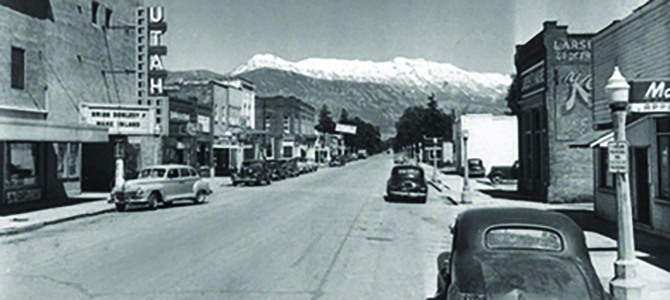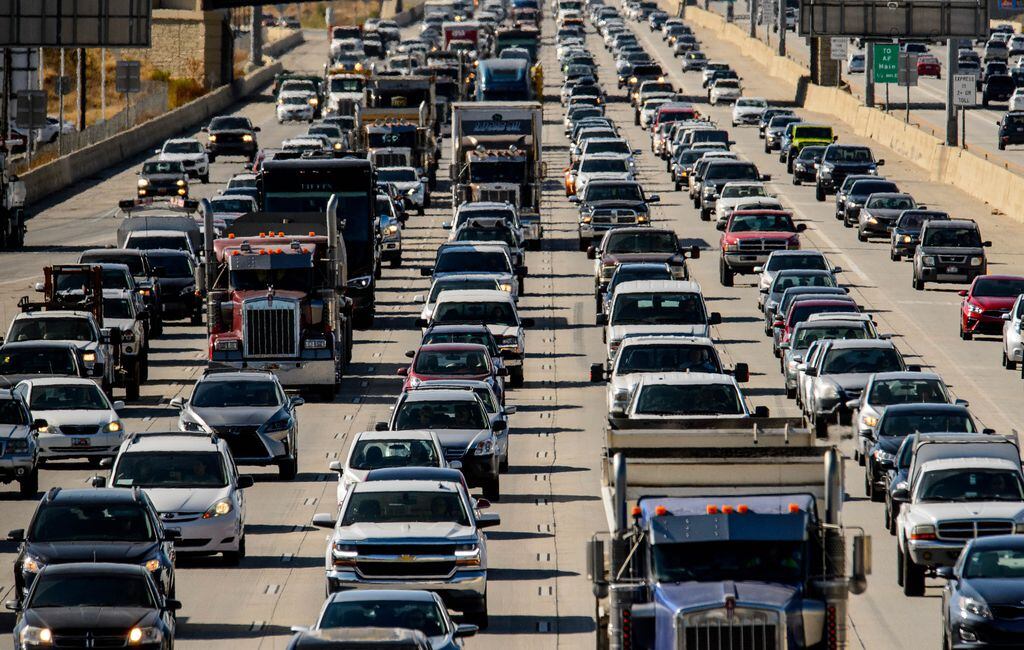There is No Escape
(Note: Car infrastructure is the design in which a city prioritizes the car over the pedestrian in everything from road design to zoning. There is little to no compromise, the car always comes first. Pedestrian infrastructure has cars, but the pedestrian always comes first. These cities are often healthier, peaceful, prosperous, and overall happier places to live. They do not eventually become car infested.)
Little Ol' Lehi
(These streets may have been wide enough at the time, now Lehi Main Street is a nightmare during rush hour and it's only getting worse. Should we demolish historic downtown for better roads?)

(1)
I just visited a Lehi City Planning meeting. New urban and high dense housing is going to be placed directly in between Thanksgiving point and Traverse Mountain. Two thousand homes. The neighborhood has zero mixed zoning, and there will be only one bus that routes around the area. Thousands of cars will infest an already clogged freeway. No one will use the bus, because... why would they? Anyone who has driven on thanksgiving way knows the minding numbing traffic already involved. Resident after resident stood up to oppose the plan. A plan which has been in the works for five years now. I felt sad listening to their reasons.
Concerns
"I didn't move to Lehi to live near an urban city." "Lehi was supposed to be a peaceful farming town." "You can't put that much high density housing near Lehi, we don't want to be near the crime." "I've lived here forty years, you can't do this to the community." "The traffic will be devastating in this area, it's already bad enough." "They are going to add two new lanes of freeway to compensate for this, the freeway is going to be directly in front of my house." "This isn't Utah."
Unfortunately... what they don't understand is that this is Utah. With car obsessive infrastructure, this is how Utah was designed, and they are now experiencing the injurious consequences of our poor urban planning. Lehi is now only starting to see the consequences affect them. Our car infrastructure has no stop sign. It doesn't care who it hurts, it will continue to take, take, take.
It didn't matter
Even after everything that was said, they passed the construction plans. Lehi, the peaceful farming city; out of the way, rich in history and community, which thought it was safe from the rat race of car infrastructure is now going to be over run with car traffic. In 10 years, 20 years, Lehi may look unrecognizable, and partly bulldozed to the ground to put in more highways.
This Feels Familiar
This is the most devastating part of car infrastructure in my opinion. It's the reason I felt so moved to do something. I know what it's like to move somewhere, thinking that you will live in a peaceful and beautifully scenic city, only to realize in the blink of an eye, your entire city is now a traffic trap. Streets which used to be peaceful and quick are quickly turned into high speed stroads, in which traffic time has doubled. Your home is surrounded by speeding loud cars, and local businesses have died in favor for more corporate franchises. The farm land or trees you thought beautified your space are chopped or burned to the ground. High density housing, which you thought would never exist, is suddenly a block away. It's tragic. You feel out of control, unable to stop the influx of people coming in, but wishing you could. "People need houses, you can't stop this."
Just Run Away
(Before I understood proper urban planning, I considered moving to Wisconsin after I drove through on a family trip. It has not been affected by deep car infrastructure yet. It still very beautiful in many parts of the state.)

(2)
Because car infrastructure is unsustainable and the suburb is it's only solution, people are constantly running away, or moving deeper and deeper into their suburban neighborhoods to avoid the chaos. I spoke with a woman afterward who told me she had moved 5 times in Washington to avoid the rising population and traffic until she finally moved to Lehi. Unfortunately, it wasn't enough.
When I first started becoming interested in helping Utah, people rejected my ideas immediately. They simply questioned why I did not just leave Utah for a prettier and more peaceful area.
This is why. As painful as it is for me to live in Utah right now and see the scars of our car infrastructure wreak continual havoc on its less fortunate residence, there is no escape. I cannot run away from this problem, with what I now know, even if I wanted to. If we don't properly redesign our cities and put a stop to this, it does not matter where you live, you will never escape car traffic. It may take decades in some areas, and some may never experience it in their lifetimes if they're lucky, but their children will suffer it, and their children's children will wonder why nobody put a stop to it. We continue to run, hoping to find peace, but it's always one step closer to our door.
(Salt Lake City rush hour)

(3)
Why does this happen?
It's supply and demand. Suburban neighborhoods build nonfunctional sprawled communities in which you must take your car to do things. They are extremely exclusive, never letting any other type of housing or business into their neighborhoods. All of this is to "avoid car traffic, so their communities can continue to be safe and peaceful. If cities were designed better this wouldn't be an issue.
Unfortunately, as the population naturally rises, so do more suburban neighborhoods. People leave suburbia with the car to work or to do errands. This adds traffic to the road. This irritates the public, and they call for more roads. The traffic is temporarily fixed, after they bulldoze thousands of buildings and land to do it. They build more suburbs, which adds more traffic, which irritates the public, which makes more roads. In the case that it doesn't add a new suburb and the population influx is too rapid, they add new high density housing which wasn't planned and isn't suited, and often doubles the amount of previous traffic.
(Only one example of American Fork single houses that were built next to the freeway. Still too close in my opinion, but in the next decade, it may be feet from their front door.)
Pretty soon, the outskirts of these places either get the freeway in front of their house, or taken away from them. Eventually after that, even the middle of these suburbs begin to see traffic with high speed and wide stroads cutting through their previously peaceful spaces. In the end, only the wealthy elite start to afford million dollar suburb properties so removed from car traffic, they can pretend it doesn't exist. While also contributing to the problem.
People of course, without proper education on what's going on, always blame the high density housing as though it's the nature of the housing that is the problem. "You can't put high density housing here! We don't want it!" The attitude of a typical suburbanite is essentially, "You can live in a shoe box if you need to in some awful traffic riddled part of town, but you can't live near me." This is how places turn into crime infested slums. Suburbanites enjoy peaceful atmospheres and a yard, but everyone else has to suffer the car traffic. That is... until it comes directly to their door at some point. Queue frantic Lehi citizens.
What I proposed
I stood up and explained high density housing was not problematic, and can be even safer for families and children if done correctly. I explained that high density housing was not an inherent evil, and that we needed it to be properly done more than ever in our quickly expanding population. Particularly for the displaced young Utah families who are struggling to find suitable homes. That we cannot not stop people from coming into the state, and that Lehi could continue to be bulldozed over by big money and cars, or they could have a say in a properly urbanized spaces. To maintain the peace Lehi so desperately wants, we need to shift out of car centric infrastructure.
(Well designed and beautiful high density housing. Peaceful atmosphere. Marylebone, England. Notice the wide biking paths and mixed zoning businesses underneath for pedestrians. Streets are safe for both cars and pedestrians.)

(4)
A comment was made at my expense after I was done, explaining that they appreciated the enthusiasm of the youth, but I had romanticized reality. I was unfortunately laughed at by the group at large after I sat down. And I believe I had even angered some of the older folk. Of course, with only three minutes to explain my position, I do not blame Lehi for their immediate rejection and misunderstanding. Properly designed American cities do not exist anymore. It is very difficult for people to conceptualize better infrastructure as they have never seen it. There is also a rabid fear I am trying to steal away their cars and make them "walk to Costco in the snow". High density in America often does comes with a lot of crime, with loud and dangerous environments. There is both history and infrastructure failing attached to that consequence. That's how America functions right now. So of course, Lehi was devastated that more people were coming into their area.
What can be done?
(Almost designed like Disneyland it's so pedestrian friendly. High density housing done well with mixed zoning. Everything about it is beautiful, prosperous, long lasting and peaceful.)

(4)
We need a complete mind shift in how our cities are designed. Suburban areas don't need to go away, they need to be completely overhauled with functional mixed zoning. We need to turn our suburban spaces into villages, in which neighborhoods can freely contribute to businesses with livestock, produce, and services.We need high density urbanized cities that are designed well so that families with young children are happy to live there as they are safer, and more functional. Instead of designing all of our roads for cars, we need to start designing our communities around the pedestrians. That means our roads need to be rethought back into streets and roads and spaces need to be carved specifically out for pedestrians to feel safe and peaceful. Suburbanites need to allow good public transportation into their spaces. We don't have to compromise peace for better designed cities in favor of car obsessive infrastructure in which we think we are more free. Let cars have their place, but design our cities around people, not cars.
Utah needs to understand the suffering they are experiencing right now, and the catastrophic events that are to follow if we do not fix this. Lower to middle income families and Utahns are already feeling the heavy affects, but all of Utah is suffering under the weight of car infrastructure. Lehi is on track to look like car infested Las Vegas. Is this what we want? Or do we want peaceful cities that mirror pre-world war American Ways, and current European infrastructure. Which peaceful farm centric city will be run over next? Logan? Midway? Springville? Spanish Fork? Lehi couldn't stop it, because there is a population need that will be met. So is Utah going to stand up and fight for better infrastructure and our green peaceful land or are we going be stubborn, and let Utah turn into a soulless, traffic riddled, corporate parking lot?
(1)https://www.lehi-ut.gov/community/about-lehi/
(2)https://travel.usnews.com/features/top-things-to-do-in-wisconsin
(3)https://www.sltrib.com/news/politics/2020/01/29/salt-lake-traffic/
(4)https://www.expatica.com/uk/moving/location/top-places-to-live-in-london-107932/

